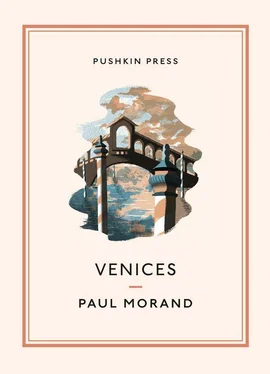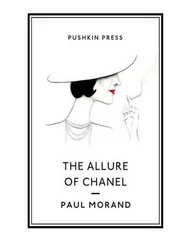Paul Morand - Venices
Здесь есть возможность читать онлайн «Paul Morand - Venices» весь текст электронной книги совершенно бесплатно (целиком полную версию без сокращений). В некоторых случаях можно слушать аудио, скачать через торрент в формате fb2 и присутствует краткое содержание. Год выпуска: 2013, Издательство: Pushkin Collection, Жанр: Современная проза, на английском языке. Описание произведения, (предисловие) а так же отзывы посетителей доступны на портале библиотеки ЛибКат.
- Название:Venices
- Автор:
- Издательство:Pushkin Collection
- Жанр:
- Год:2013
- ISBN:нет данных
- Рейтинг книги:5 / 5. Голосов: 1
-
Избранное:Добавить в избранное
- Отзывы:
-
Ваша оценка:
- 100
- 1
- 2
- 3
- 4
- 5
Venices: краткое содержание, описание и аннотация
Предлагаем к чтению аннотацию, описание, краткое содержание или предисловие (зависит от того, что написал сам автор книги «Venices»). Если вы не нашли необходимую информацию о книге — напишите в комментариях, мы постараемся отыскать её.
Venices — читать онлайн бесплатно полную книгу (весь текст) целиком
Ниже представлен текст книги, разбитый по страницам. Система сохранения места последней прочитанной страницы, позволяет с удобством читать онлайн бесплатно книгу «Venices», без необходимости каждый раз заново искать на чём Вы остановились. Поставьте закладку, и сможете в любой момент перейти на страницу, на которой закончили чтение.
Интервал:
Закладка:
A well-known passage by Philippe de Commynes, the most ingenuous and probably the oldest description of Venice in the French language, is devoted to Fusina; I’ve always had such a strong affection for it that I must quote it in passing: “The day lay before me on the morning I arrived in Venice and I went as far as Chafusine [Fusina] which is five miles from Venice; there you leave the boat on which you have come, along a river, from Padua, and you climb into little boats that are very clean and covered in fine tapestries with beautiful velvet carpets inside… The sea is extremely calm there… You have a view of Venice and a conglomeration of houses all surrounded by water…”
The Brenta is no longer the summer-time river whose Alpine waters cooled Venice’s holidaymakers; tatty huts replace the trees, the water is the colour of olive oil and on its surface float the bloated corpses of dead cats, discarded crates and empty tin cans: pylons and power lines form the dense vegetation of the new Italy; ducks attempt to swim among the plastic bottles, those latter-day water-lilies; next come a few willow trees (one understands why they weep), or reeds that resemble the plumes of the bersaglieri ; over the water, swing bridges, looking haughty and poorly laminated, raise their metal arms for the present-day Burchiello , which has nothing in common with its ancestor (“Bucentaurus’s grandchild”, De Brosses used to say), a vessel with fifty seats, decked out in varnish, chrome and banners, and which sounds its siren impatiently from the bottom of the locks, where it is sometimes forgotten.
It is in winter that the Venetians of former times used to take refuge in the city, after the hunting season, when in November the bora had begun to blow from the heights of Grappa. The dances and public life continued until June; then people would return back along the Brenta, or go to their Palladian villas in the Euganean hills. It was in the sixteenth century that the Brenta became fashionable; each patrician family owned one or more villas there; the Pisanis had as many as fifty of them; the Contarini’s residence, at Piazzola, boasted five organs, two theatres into which five horse-drawn carriages, side by side, could be driven, a lake, and enough bedrooms to house one hundred and fifty guests, as well as their servants.
The earliest fourteenth or fifteenth century engravings depict fortified, crenellated houses without windows or staircases; two or three centuries later they have become quite different sorts of dwellings, such as those we see in the Tiepolos or Longhis in the Rezzonico museum, or those in the rustic scenes in the Papadopoli gallery. The atmosphere is one of indolence, with music, siestas, ladies prattling, their husbands chatting to their servants on horseback, surrounded by a horde of friends, parasites, clavichord players, all of them gazing intently at the tables upon which piles of pewter dishes await the arrival of the food.
I don’t know in what state the hundreds of villas I once visited are now in; they all used to be more or less the same, with their cast-iron gates that could not be opened because of the long grass, and their pilasters crowned with obelisks or statues of divinities wearing lichen for wigs; what has been left of them by the developers, by devaluation and by those who live in them? Only the Villa Pisani de Stra, which is maintained by the State, has its future assured. But what has become of the Psyche Room and the trompe l’oeil ceilings of the Villa Venier; those at the Casa Widmann; the chinoiserie at the Villa Barbariga; the games room at the Villa Giustiniani; the Juno room at the Villa Grimani; all those gardens of Armida or of The Dream of Polyphilus and all that enchantment of the houses I once knew, some of them intact after three centuries, while others lay in ruins? And of their almond-green or pale pink drawing-rooms, the walls cracked from top to bottom, filled with ploughs and harrows and carts into which Veronese’s goddesses, or the dancers of Tiepolo’s minuet, have fallen from the ceiling in great slabs, rotting with damp and dilapidation?
I have over-indulged in Palladio (one can get indigestion from lean fare); this dictatorship of antiquity over three centuries, from Stockholm to the Brenta, from Lisbon to St Petersburg, and these rigid façades of Greek temples encasing a block of bricks can sometimes offend the imagination; it needs all the genius of a Gabriel,13 allied to what is the most beautiful material in the world after Pentelic marble, Vaugirard stone, to dispel the tedium of the neo-classical.
LA MALCONTENTA
THE PRIVATELY OWNED gondolas at their moorings nod their iron prows sadly as we pass by; we disturb their slumber. The first villa at which the Burchiello stops is La Malcontenta. The origin of its name is obscure, it may be that a woman of the Foscari family, to whom the house belonged, was once confined there for bad behaviour, or possibly local people were unhappy about water being brought there, which meant it was taken from them.
I scarcely recognized the villa, so shaded was it by Italian poplars, those beautiful trees that grow so quickly; I had remembered a house that was dramatically isolated, and now I found it surrounded by formal lawns. It had been beautiful the way it was, its lines intact, purified by poverty and solitude, just as the centuries had left it, ever since 1560, far away from anything, in a bare landscape, haunted by ladri and rapinatori ,
Balzac set a scene there, one in which Massimilla Doni holds the handsome Emilio by the hand; hidden away between the Lagoon and the mountains, Massimilla bemoans her over-respectful lover… Did Balzac know the Brenta, or did he have the same instinctive sense about the countryside that he had for people? His description of a Palladian palazzo has all the precision of those legal documents that are justifiably known as writs.
In about 1928, Catherine and Bertie had discovered La Malcontenta in the state in which it had been left after the Austrian bombardment during the siege of 1848. Bertie had decided to buy the villa and to restore it: an entire lifetime would not have sufficed; lying abandoned in the middle of cornfields, among willow trees that were not much more than stumps, and amid pools of stagnating waters, La Malcontenta dominated the flat river plain; initially a mountain stream, like the Isonzo, the Mincio, the Adda or the Tagliamento, and exhausted by its descent from the high Alps, the Brenta flattens out into pools as it approaches the Lagoon; its dull, lacklustre waters, the colour of engine oil and shimmering with rust, seem to be reluctant to reach Mestre; its banks of cracked mud, its bridges that cast no reflection, and the impervious surface of its waters have created an unspeakable stew that no wind can ruffle; the ancient maps trace its course: imitating the other rivers of the Dolomites, the Brenta displays the tentacles of an octopus encircling Venice.
With all the patience of the eager enthusiast, but with out any money, Bertie had lugged bedding, Brazilian hammocks and tents from the upper Amazon to La Malcontenta; Catherine, tireless, imperious, uncompromising, and intent upon her futile quest, supported him with her exuberance. At the centre point of a Latin cross at which four rooms converged, meals were served upon a ping-pong table that was weighed down with all the fruits of the Rialto, on china that came from the flea-market, while Catherine, the descendant of Vittoria Cappello doubling as a rag and bone woman, got on with the restoration of the building.
The parties at La Malcontenta were a bit like Plato’s Banquet and a bit like Rabelais’s Abbaye de Thélème. In rooms painted in a very soft, sometimes pinkish, light-straw colour, the guests made their way into the past through simulated doors. There was no furniture, just bales of straw for chairs, and crates. (As an anonymous visitor, yesterday I recognized the gigantic eighteenth-century maps of the world, and even a portrait of Bertie.)
Читать дальшеИнтервал:
Закладка:
Похожие книги на «Venices»
Представляем Вашему вниманию похожие книги на «Venices» списком для выбора. Мы отобрали схожую по названию и смыслу литературу в надежде предоставить читателям больше вариантов отыскать новые, интересные, ещё непрочитанные произведения.
Обсуждение, отзывы о книге «Venices» и просто собственные мнения читателей. Оставьте ваши комментарии, напишите, что Вы думаете о произведении, его смысле или главных героях. Укажите что конкретно понравилось, а что нет, и почему Вы так считаете.












